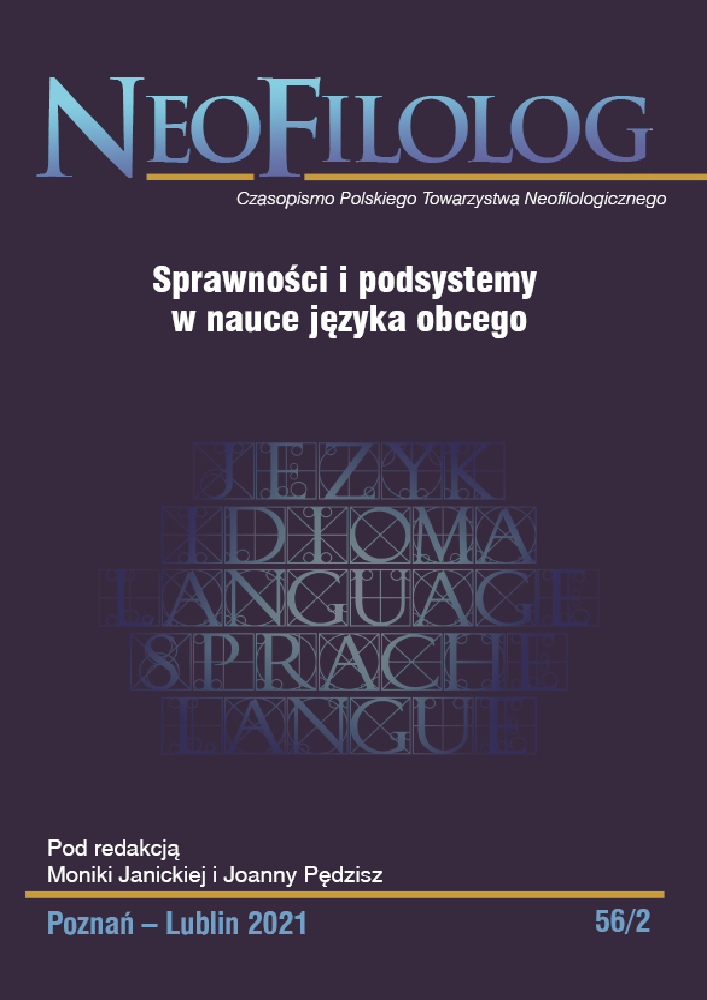Abstrakt
The aim of the article is to investigate cross-linguistic influence (CLI) of foreign languages on the L1 also referred to as L1 drift. The influence is measured by means of the degree of intervocalic stop occlusion in all the languages of L1 Polish, L2 Spanish and L3 English multilinguals. Although Polish is a language with no systemic spirantization of intervocalic stops, the assumption is that if L1 Polish is under the influence of L2 Spanish in multilinguals the degree of intervocalic stop occlusion may be lower in the otherwise non-spirantized context in L1 Polish. The degree of intervocalic stop occlusion is calculated with measures of intensity: Cmin, Vmax; but also with measures of relative intensity used in spirantization research: IntDiff and IntRatio. The results show that only Cmin and Vmax effectively capture the influence of L2 on L1, whereas the extent of the influence is conditioned by how well the speakers master spirantization in their L2 Spanish. Finally, as predicted, the L3 does not constitute a source of influence for the L1.
Bibliografia
Boersma P., Weenink D. (2014), Praat: doing phonetics by computer [Com-puter program]. Version 5.3.77, retrieved 23 December 2014 from http://www.praat.org/
Brown G. (1990), Listening to Spoken English. New York: Longman.
Cabrelli Amaro J. (2017). Testing the Phonological Permeability Hypothesis: L3 phonological effects on L1 versus L2 systems. “International Journal of Bilingualism”, No 21(6), pp. 698–717.
Cabrelli Amaro J., Rothman J. (2010). On L3 acquisition and phonological permeability: A new test case for debates on the mental representa-tion of non-native phonological systems. “International Review of Ap-plied Linguistics in Language”, No 48(2), pp. 275–296.
Chang C.B. 2019. Phonetic drift, (in:) Schmid M. S., Köpke B. (eds.), The Oxford Handbook of Language Attrition. Oxford: Oxford University Press, pp. 191–203.
Cole J., Hualde J. I., Khalil I. (1999), Effects of prosodic and segmental context on/g/-lenition in Spanish, (in:) Fujimura O., Joseph B. D., Palek B. (eds.), Proceedings of the Fourth International Linguistics and Phonetics Conference. Prague: The Karolinum Press, pp. 575–589.
de Leeuw E., Tuscha A., Schmid M.S. (2018). Individual phonological attrition in Albanian–English late bilinguals. “Bilingualism: Language and Cognition”, 21(2), pp. 278–295.
Dziubalska-Kołaczyk K., Weckwerth J. (2012), The ‘native speaker’ and prototypicality, (in:) Agnihotri R. K., Singh R. (eds.), Indian English: Towards a new paradigm. Hyderabad: Orient BlackSwan, pp. 225–230.
Elliott R.A. (1997), On the teaching and acquisition of pronunciation within a communicative approach. “Hispania”, No 80(1), pp. 96–108.
Face T.L., Menke M.R. (2009), Acquisition of the Spanish Voiced Spirants by Second Language Learners, (in:) Collentine J., García M., Lafford B., Marcos Marín F. (eds.), Selected Proceedings of the 11th Hispanic Linguistics Symposium. Somerville, MA: Cascadilla, pp. 39–52.
Fairbanks G., House A.S., Stevens E. L. (1950), An experimental study of vowel intensities. “Journal of the Acoustical Society of America”, No (22)1, pp. 457–459.
Flege J.E. (1995), Second language speech learning: Theory, findings, and problems, (in:) Strange W. (ed.), Speech Perception and Linguistic Experience: Issues in Cross-Language Research. Timonium: York Press, pp. 233–277.
Gass S.M., Selinker L. (2001), Second language acquisition: An introductory course, 2nd ed. Mahwah, NJ: Lawrence Erlbaum.
Gimson A.C. (1980), An introduction to the pronunciation of English. London: Edward Arnold.
González-Bueno M. (1995), Adquisición de los alófonos fricativos de las oclusivas sonoras españolas por aprendices de español como segunda lengua. “Estudios de lingüística aplicada”, No 13, pp. 64–79.
Hualde J.I. et al. (2010). Quantifying Iberian spirantization: Acoustics and articulation. Seattle, WA: LSRL 40.
Hualde J.I., Simonet M., Nadeu M. (2011), Consonant lenition and phono-logical recategorization. “Laboratory Phonology”, No 2(2), pp. 301–329.
Lang B., Davidson L. (2017). Effects of Exposure and Vowel Space Distribution on Phonetic Drift: Evidence from American English Learners of French. “Language and Speech”, No 62(1), pp. 30–60.
Martínez Celdrán E. (1991), Sobre la naturaleza de los alófonos de /b,d,g/ en español y sus distintas denominaciones. “Verba”, No 18(1), pp. 235–253.
Mascaró J. (1991), Iberian spirantization and continuant spreading. “Catalan Working Papers in Linguistics”, No 1(1), pp. 167–179.
Navarro Tomás T. (1918), Manual de pronunciación española. Madrid: Centro de Estudios Históricos.
Paradis M. (2004), A neurolinguistic theory of bilingualism. Amsterdam: John Benjamins.
Parrell B. (2010), Articulation from acoustics: Estimating constriction degree from the acoustic signal. “Journal of the Acoustical Society of Ameri-ca”, No 128(4), p. 2289.
Sawicka I. (1995), Fonologia, (in:) Wróbel, H. (ed.), Gramatyka współczes-nego języka polskiego, Vol 3. Kraków: Wydawnictwo Instytutu Języka Polskiego PAN, pp. 107–195.
Sypiańska J. (2016), L1 vowels of multilinguals: The applicability of SLM in multilingualism. “Research in Language”, No 14(1), pp. 79–94.
Sypiańska J. (2017), Cross-linguistic influence in bilinguals and multilinguals. Poznań: Wydawnictwo Naukowe UAM.
Weinreich U. (1953), Languages in Contact. Findings and Problems. New York: Linguistic Circle of New York.
Zampini M. (1994), The role of native language transfer and task formality in the acquisition of Spanish spirantization. “Hispania”, No 77(3), pp. 470–481.
Licencja
Prawa autorskie (c) 2021 Jolanta Sypiańska

Utwór dostępny jest na licencji Creative Commons Uznanie autorstwa – Bez utworów zależnych 4.0 Międzynarodowe.
Przedstawiany utwór (artykuł) upubliczniany jest na podstawie umowy z autorem i na licencji Creative Commons Attribution-NoDerivatives 4.0 International (CC BY-ND 4.0).
Użytkownicy mają obowiązek podania wraz z rozpowszechnionym utworem, informacji o autorstwie, tytule, źródle (odnośniki do oryginalnego utworu, DOI) oraz samej licencji;
- bez tworzenia utworów zależnych,
- utwór musi być zachowany w oryginalnej postaci.
Uniwersytet im. Adama Mickiewicza w Poznaniu zachowuje prawo do czasopisma jako całości (układ, forma graficzna, tytuł, projekt okładki, logo itp.).

